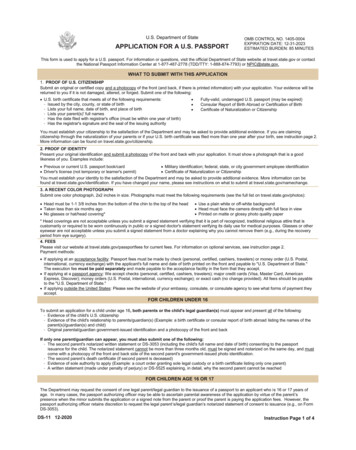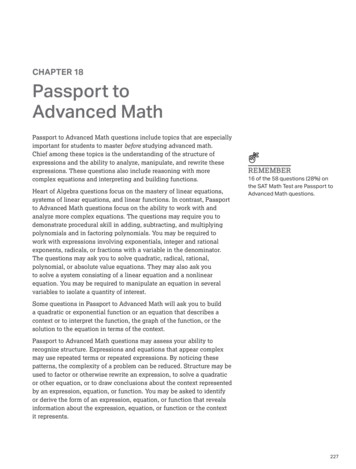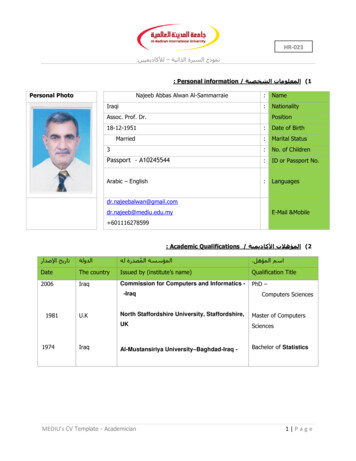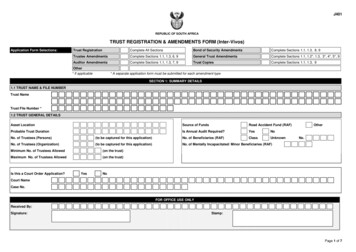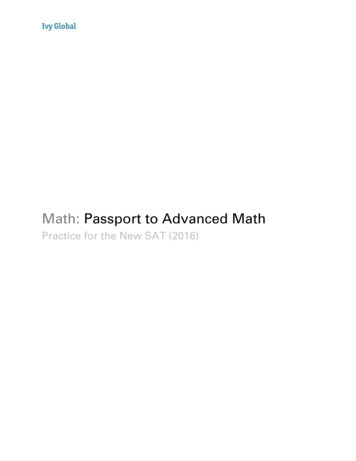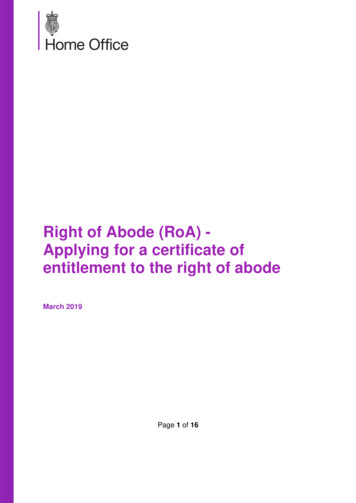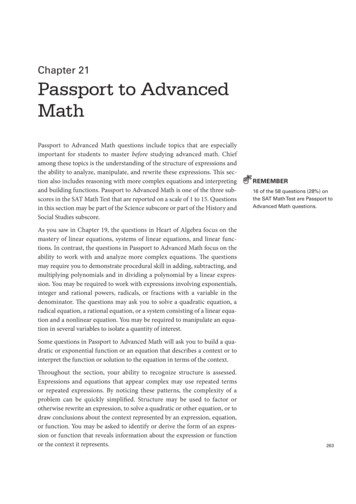
Transcription
Chapter 21Passport to AdvancedMathPassport to Advanced Math questions include topics that are especiallyimportant for students to master before studying advanced math. Chiefamong these topics is the understanding of the structure of expressions andthe ability to analyze, manipulate, and rewrite these expressions. This sec tion also includes reasoning with more complex equations and interpretingand building functions. Passport to Advanced Math is one of the three subscores in the SAT Math Test that are reported on a scale of 1 to 15. Questionsin this section may be part of the Science subscore or part of the History andSocial Studies subscore.REMEMBER16 of the 58 questions (28%) onthe SAT Math Test are Passport toAdvanced Math questions.As you saw in Chapter 19, the questions in Heart of Algebra focus on themastery of linear equations, systems of linear equations, and linear func tions. In contrast, the questions in Passport to Advanced Math focus on theability to work with and analyze more complex equations. The questionsmay require you to demonstrate procedural skill in adding, subtracting, andmultiplying polynomials and in dividing a polynomial by a linear expres sion. You may be required to work with expressions involving exponentials,integer and rational powers, radicals, or fractions with a variable in thedenominator. The questions may ask you to solve a quadratic equation, aradical equation, a rational equation, or a system consisting of a linear equa tion and a nonlinear equation. You may be required to manipulate an equa tion in several variables to isolate a quantity of interest.Some questions in Passport to Advanced Math will ask you to build a qua dratic or exponential function or an equation that describes a context or tointerpret the function or solution to the equation in terms of the context.Throughout the section, your ability to recognize structure is assessed.Expressions and equations that appear complex may use repeated termsor repeated expressions. By noticing these patterns, the complexity of aproblem can be quickly simplified. Structure may be used to factor orotherwise rewrite an expression, to solve a quadratic or other equation, or todraw conclusions about the context represented by an expression, equation,or function. You may be asked to identify or derive the form of an expres sion or function that reveals information about the expression or functionor the context it represents.263
M AT HPassport to Advanced Math questions also assess your understanding offunctions and their graphs. A question may require you to demonstrate yourunderstanding of function notation, including interpreting an expressionwhere the argument of a function is an expression rather than a variable. Thequestions may assess your knowledge of the domain and range of a functionand your understanding of how the algebraic properties of a function relateto the geometric characteristics of its graph.The questions in this section include both multiple-choice questions andstudent-produced response questions. On some questions, the use of acalculator is not permitted; on other questions, the use of a calculator isallowed. On questions where the use of a calculator is permitted, you mustdecide whether using your calculator is an effective strategy.Let’s consider the content and skills assessed by Passport to AdvancedMath questions.Operations with Polynomials and RewritingExpressionsQuestions on the SAT Math Test may assess your ability to add, subtract,and multiply polynomials.EXAMPLE 1(x2 bx 2)(x 3) x3 6x2 7x 6In the equation above, b is a constant. If the equation is true for allvalues of x, what is the value of b?REMEMBERPassport to Advanced Mathquestions build on theknowledge and skills testedon Heart of Algebra questions.Develop proficiency with Heart ofAlgebra questions before tacklingPassport to Advanced Mathquestions.264A)B)C)D)2379To find the value of b, expand the left-hand side of the equation and then collectlike terms so that the left-hand side is in the same form as the right-hand side.(x2 bx 2)(x 3) (x3 bx2 2x) (3x2 3bx 6) x3 (3 b)x2 (3b 2)x 6
PA S S P O R T T O A DVA N C E D M AT HSince the two polynomials are equal for all values of x, the coefficient of match ing powers of x should be the same. Therefore, x3 (3 b)x2 (3b 2)x 6and x3 6x2 7x 6 reveals that 3 b 6 and 3b 2 7. Solving either of theseequations gives b 3, which is choice B.Questions may also ask you to use structure to rewrite expressions. Theexpression may be of a particular type, such as a difference of squares, or itmay require insightful analysis.EXAMPLE 2Which of the following is equivalent to 16s4 4t2?A) 4(s2 t)(4s2 t)B) 4(4s2 t)(s2 t)C) 4(2s2 t)(2s2 t)D) (8s2 2t)(8s2 2t)This example appears complex at first, but it is very similar to the equationx2 y2 and this factors as (x y) (x y). The expression 16s4 4t2 is also the2difference of two squares: 16s4 4t2 (4s2) (2t)2. Therefore, it can be fac 2tored as (4s2) (2t)2 (4s2 2t) (4s2 2t). This expression can be rewrittenas (4s2 2t) (4s2 2t) 2(2s2 t) (2) (2s2 t) 4(2s2 t) (2s2 t), which ischoice C.PRACTICE ATkhanacademy.org/satPassport to Advanced Mathquestions require a high comfortlevel working with quadraticequations and expressions,including foiling and factoring.Recognizing classic quadraticssuch as x 2 y 2 (x y)(x y)can also improve your speed andaccuracy.EXAMPLE 3y5 2y4 cxy 6xIn the polynomial above, c is a constant. If the polynomial is divisibleby y 2, what is the value of c?If the expression is divisible by y 2, then the expression y 2 canbe factored from the larger expression. Since y5 2y4 (y 2)y4, youhave y5 2y4 cxy 6x (y 2) (y4) cxy 6x. If this entire expres sion is divisible by y 2, then cxy 6x must be divisible by y 2. Thus, cxy 6x (y 2)( cx) cxy 2cx. Therefore, 2c 6, and the value of c is 3.265
M AT HQuadratic Functions and EquationsQuestions in Passport to Advanced Math may require you to build a qua dratic function or an equation to represent a context.EXAMPLE 4PRACTICE ATkhanacademy.org/satExample 4 requires carefultranslation of a word probleminto an algebraic equation.It pays to be deliberate andmethodical when translatingword problems into equations onthe SAT.A car is traveling at x feet per second. The driver sees a red light ahead,and after 1.5 seconds reaction time, the driver applies the brake. Afterxthe brake is applied, the car takes seconds to stop, during which24xtime the average speed of the car is feet per second. If the car travels2165 feet from the time the driver saw the red light to the time it comesto a complete stop, which of the following equations can be used tofind the value of x?A) x2 48x 3,960B) x2 48x 7,920C) x2 72x 3,960D) x2 72x 7,920During the 1.5-second reaction time, the car is still traveling at x feet persecond, so it travels a total of 1.5x feet. The average speed of the car duringxxthe -second braking interval is feet per second, so over this interval, the242xxx2 feet. Since the total distance the car travels from thecar travels2 24 48time the driver saw the red light to the time it comes to a complete stop isx2165 feet, you have the equation 1.5x 165. This quadratic equation can48be rewritten in standard form by subtracting 165 from each side and thenmultiplying each side by 48, giving x 2 72x 7,920, which is choice D.( )( )REMEMBERThe SAT Math Test may ask youto solve a quadratic equation. Beprepared to use the appropriatemethod. Practice using thevarious methods (below) untilyou are comfortable with all ofthem.1. Factoring2. Completing the square3. Quadratic formula4. Using a calculator (if permitted)266Some questions on the SAT Math Test will ask you to solve a quadraticequation. You must determine the appropriate procedure: factoring, com pleting the square, the quadratic formula, use of a calculator (if permitted),or use of structure. You should also know the following facts in addition tothe formulas in the directions:f The sum of the solutions of x 2 bx c 0 is b.f The product of the solutions of x2 bx c 0 is c.Each of the facts can be seen from the factored form of a quadratic. If r ands are the solutions of x 2 bx c 0, then x2 bx c (x r)(x s). Thus,b (r s) and c ( r)( s).
PA S S P O R T T O A DVA N C E D M AT HEXAMPLE 5What are the solutions x of x2 3 x?A)B)C)D) 1 112 1 1321 1121 132The equation can be solved by using the quadratic formula or by com pleting the square. Let’s use the quadratic formula. First, subtract x fromeach side of x2 3 x to put it in standard form: x2 x 3 0. The qua dratic formula states the solutions x of the equation ax2 bx c 0 are b b2 4ac. For the equation x2 x 3 0, you have a 1, b 1,2aand c 3. Substituting these formulas into the quadratic formula gives2 ( 1) ( 1) 4(1)( 3)1 ( 12)1 1 13 , which isx 222(1)choice D.PRACTICE ATkhanacademy.org/satThe quadratic formula statesthat the solutions x of theequation ax 2 bx c 0 are b b 2 4acx ——.2aEXAMPLE 6If x 0 and 2x2 3x 2 0, what is the value of x?The left-hand side of the equation can be factored: 2x2 3x 2 (2x 1)(x 2) 0.12Therefore, either 2x 1 0, which gives x , or x 2 0, which gives x 2.12Since x 0, the value of x is .EXAMPLE 7REMEMBERPay close attention to all ofthe details in the question.1In Example 6, x can equal2 or 2, but since the question statesthat x 0, the value of x must1be2.What is the sum of the solutions of (2x 1)2 (x 2)2?If a and b are real numbers and a2 b2, then either a b or a b. Since(2x 1)2 (x 2)2, either 2x 1 x 2 or 2x 1 (x 2). In the first case,1 . Therefore, the sum of thex 3, and in the second case, 3x 1, or x 38122.solutions x of (2x 1) (x 2) is 3 33( ) ()267
M AT HExponential Functions, Equations, andExpressions and RadicalsWe examined exponential functions in Examples 7 and 8 of Chapter 20.Some questions in Passport to Advanced Math ask you to build a functionthat models a given context. As discussed in Chapter 20, exponential func tions model situations in which a quantity is multiplied by a constant factorfor each time period. An exponential function can be increasing with time,in which case it models exponential growth, or it can be decreasing withtime, in which case it models exponential decay.EXAMPLE 8A researcher estimates that the population of a city is declining at anannual rate of 0.6%. If the current population of the city is 80,000,which of the following expressions appropriately models the populationof the city t years from now according to the researcher’s estimate?A)B)C)D)PRACTICE ATkhanacademy.org/satA quantity that grows or decaysby a fixed percent at regularintervals is said to possessexponential growth or decay.Exponential growth isrepresented by the functiony a(1 r)t, while exponentialdecay is represented by thefunction y a(1 r )t, where yis the new population, a is theinitial population, r is the rateof growth or decay, and t is thenumber of time intervals thathave elapsed.26880,000(1 0.006)t80,000(1 0.006t)80,000 1.006t80,000(0.006t)According to the researcher’s estimate, the population is decreasing by 0.6%each year. Since 0.6% is equal to 0.006, after the first year, the population is80,000 0.006(80,000) 80,000(1 0.006). After the second year, the pop ulation is 80,000(1 0.006) 0.006(80,000)(1 0.006) 80,000(1 0.006)2.Similarly, after t years, the population will be 80,000(1 0.006)t according tothe researcher’s estimate. This is choice A.Another well-known example of exponential decay is the decay of a radioac tive isotope. One example is iodine-131, a radioactive isotope used in somemedical treatments. The decay of iodine-131 emits beta and gamma radiation,and it decays to xenon-131. The half-life of iodine-131 is 8.02 days; that is,after 8.02 days, half of the iodine-131 in a sample will have decayed to xenon 131. Suppose a sample of A milligrams of iodine-131 decays for d days. Every1 , or 2 1. In d days, a total8.02 days, the quantity of iodine-131 is multiplied by2dofdifferent 8.02-day periods will have passed, and so the original quantity8.02dwill have been multiplied by 2 1 a total of times. Therefore, the amount, in8.02ddmilligrams, of iodine-131 remaining in the sample will be A(2 1)8.02 A( 2 8.02 ).1 2 1. Questions on theIn the preceding discussion, we used the identity2SAT Math Test may require you to apply this and other laws of exponentsand the relationship between powers and radicals.
PA S S P O R T T O A DVA N C E D M AT HEXAMPLE 91 n ?Which of the following is equivalent to x( )nA) x 2nB) x 21C) xn 21D) xn 2n( ) (x11 x 21, and1The square root x is equal to x 2 . Thus, x xChoice B is the correct answer.1 n2 ) xn2 .An SAT Math Test question may also ask you to solve a radical equation. Insolving radical equations, you may square both sides of an equation. Sincesquaring is not a reversible operation, you may end up with an extraneousroot, that is, a root to the simplified equation that is not a root to the originalequation. Thus, when solving a radical equation, you should check any solu tion you get in the original equation.PRACTICE ATkhanacademy.org/satPractice your exponent rules.1Know, for instance, that x x 21 x 12 .and that xEXAMPLE 10x 12 x 44What is the solution set for the above equation?A)B)C)D){5}{20}{ 5, 20}{5, 20}Squaring each side of x 12 x 44 gives(x 12)2 ( x 44 )2 x 44x2 24x 144 x 44x2 25x 100 0(x 5)(x 20) 0The solutions to the quadratic are x 5 and x 20. However, since the firststep was to square each side of the given equation, which is not a revers ible operation, you need to check x 5 and x 20 in the original equation.Substituting 5 for x gives5 445 12 7 49269
M AT HPRACTICE ATkhanacademy.org/satA good strategy to use whensolving radical equations isto square both sides of theequation. When doing so,however, be sure to check thesolutions in the original equation,as you may end up with a rootthat is not a solution to theoriginal equation.This is not a true statement (since 49 represents only the positive squareroot, 7), so x 5 is not a solution to x 12 x 44 . Substituting 20 for x gives 4420 12 20648 This is a true statement, so x 20 is a solution to x 12 x 44 . Therefore,the solution set is {20}, which is choice B.Dividing Polynomials by a LinearExpression and Solving Rational EquationsQuestions on the SAT Math Test may assess your ability to work with ratio nal expressions, including fractions with a variable in the denominator. Thismay include long division of a polynomial by a linear expression or findingthe solution to a rational equation.EXAMPLE 11RWhen 6x2 5x 4 is divided by 3x 2, the result is 2x 3 ,(3x 2)where R is a constant. What is the value of R?Performing the long division gives2x 33x 2 )6x 2 5x 46x2 4x 9x 4 9x 610Therefore, the remainder is 10.If ax b is a factor of the polynomial P(x), then P(x) can be written asP(x) (ax b)Q(x)for some polynomial Q(x). It follows that the solution to ax b 0, namely,bx a , is a solution to P(x) 0. More generally, if the number r is theremainder when P(x) is divided by ax b, you haveP(x) (ax b)Q(x) r( )bbIt follows that for x a , the value of P a (0)(Q(x)) r r. This is another2702way to solve Example 11. The solution of 3x 2 0 is x 3 , so the remainder2 iswhen 6x2 5x 4 is divided by 3x 2 is the value of 6x2 5x 4 when 38102 2 5 2 4 substituted for x: Remainder: 6 4 10.333 3( ) ( )
PA S S P O R T T O A DVA N C E D M AT HEXAMPLE 123 2 1t 1 t 3 4If t is a solution to the equation above and t 0, what is the value of t ?The first step in solving this equation is to clear the variable out of thedenominators by multiplying each side by (t 1)(t 3). This gives1 (t 1)(t 3). Now multiply each side by 4 to get rid3(t 3) 2(t 1) 4of the fraction: 12(t 3) 8(t 1)(t 3). Expanding all the products andmoving all the terms to the right-hand side gives 0 t2 25. Therefore, thesolutions to the equation are t 5 and t 5. Since t 0, the value of t is 5.PRACTICE ATkhanacademy.org/satWhen solving for a variable inan equation involving fractions,a good first step is to clear thevariable out of the denominatorsof the fractions.Systems of EquationsQuestions on the SAT Math Test may ask you to solve a system of equationsin two variables in which one equation is linear and the other equation isquadratic or another nonlinear equation.EXAMPLE 133x y 32(x 1) 4(x 1) 6 yIf (x, y) is a solution of the system of equations above and y 0, what isthe value of y?The structure of the second equation suggests that (x 1) is a factor of thefirst equation. Subtracting 3x from each side of the first equation gives youy 3 3x, which can be rewritten as y 3(x 1). Substituting 3(x 1)for y in the second equation gives you (x 1)2 4(x 1) 6 3(x 1),which can be rewritten as (x 1)2 (x 1) 6 0. The structure of thisequation suggests that x 1 can be treated as a variable. Factoring gives you((x 1) 3)((x 1) 2) 0, or (x 2)(x 3) 0. Thus, either x 2, whichgives y 3 3(2) 9; or x 3, which gives y 3 3( 3) 9. Therefore,the solutions to the system are (2, 9) and ( 3, 6). Since the question states thaty 0, the value of y is 6.PRACTICE ATkhanacademy.org/satThe first step to solving thisexample is substitution, anapproach you may use on Heartof Algebra questions. The otherkey was noticing that (x 1) canbe treated as a variable.271
M AT Hy(–3, 6)x(2, –9)The solutions of the system are given by the intersection points of the twographs. Questions on the SAT Math Test may assess this or other relation ships between algebraic and graphical representations of functions.Relationships Between Algebraic andGraphical Representations of FunctionsA function f(x) has a graph in the xy-plane, which is the graph of the equa tion y f(x) (or, equivalently, consists of all ordered pairs (x, f(x)). Somequestions in Passport to Advanced Math assess your ability to relate prop erties of the function f to properties of its graph, and vice versa. You may berequired to apply some of the following relationships:f Intercepts. The x-intercepts of the graph of f correspond to valuesof x such that f(x) 0; if the function f has no zeros, its graph has nox-intercepts, and vice versa. The y-intercept of the graph of f correspondsto the value of f(0). If x 0 is not in the domain of f, the graph of f has noy-intercept, and vice versa.PRACTICE ATkhanacademy.org/satThe domain of a function is theset of all values for which thefunction is defined. The range ofa function is the set of all valuesthat are the output, or result, ofapplying the function.f Domain and range. The domain of f is the set of all x for which f(x) isdefined. The range of f is the set of all y with y f(x) for some value of xin the domain. The domain and range can be found from the graph of fas the set of all x-coordinates and y-coordinates, respectively, of pointson the graph.f Maximum and minimum values. The maximum and minimum valuesof f can be found by locating the highest and the lowest points on thegraph, respectively. For example, suppose P is the highest point onthe graph of f. Then the y-coordinate of P is the maximum value of f, andthe x-coordinate of P is where f takes on its maximum value.f Increasing and decreasing. The graph of f shows the intervals over whichthe function f is increasing and decreasing.272
PA S S P O R T T O A DVA N C E D M AT Hf End behavior. The graph of f can indicate if f(x) increases or decreaseswithout limit as x gets very large and positive or very large and negative.f Asymptotes. If the values of f approach a fixed value, say K, as x gets verylarge and positive or very large and negative, the graph of f has a horizontalasymptote at y K. If f is a rational function whose denominator is zeroand numerator is nonzero at x a, then the graph of f has a verticalasymptote at x a.f Symmetry. If the graph of f is symmetric about the y-axis, then f is aneven function, that is, f( x) f(x) for all x in the domain of f. If thegraph of f is symmetric about the origin, then f is an odd function, that is,f( x) f(x) for all x in the domain of f.f Transformations. For a graph of a function f, a change of the formf(x) a will result in a vertical shift of a units and a change of the formf(x a) will result in a horizontal shift of a units.Note: The SAT Math Test uses the following conventions about graphs inthe xy-plane unless a particular question clearly states or shows a differentconvention:f The axes are perpendicular.f Scales on the axes are linear scales.f The size of the units on the two axes cannot be assumed to be equal unlessthe question states they are equal or you are given enough information toconclude they are equal.f The values on the horizontal axis increase as you move to the right.f The values on the vertical axis increase as you move up.REMEMBERDon’t assume the size of the unitson the two axes are equal unlessthe question states they areequal or you can conclude theyare equal from the informationgiven.EXAMPLE 14The graph of which of the following functions in the xy-plane hasx-intercepts at 4 and 5?A) f(x) (x 4)(x 5)B) g(x) (x 4)(x 5)C) h(x) (x 4)2 5D) k(x) (x 5)2 4The x-intercepts of the graph of a function correspond to the zeros of thefunction. If a function has x-intercepts at 4 and 5, then the values of thefunction at 4 and 5 are each 0. The function in choice A is in factored form,273
M AT HPRACTICE ATkhanacademy.org/satwhich shows that f(x) 0 if and only if x 4 0 or x 5 0, that is, if x 4or x 5. Therefore, f(x) (x 4)(x 5) has x-intercepts at 4 and 5.Another way to think of thisquestion is to ask yourself,“Which answer choice representsa function that has values of zerowhen x 4 and x 5?”The graph in the xy-plane of each of the functions in the previous example isa parabola. Using the defining equations, you can tell that the graph of g hasx-intercepts at 4 and 5; the graph of h has its vertex at (4, 5); and the graphof k has its vertex at ( 5, 4).EXAMPLE 15y108642–4–2–2–424xThe function f (x) x 4 2.4x 2 is graphed in the xy-plane as shownabove. If k is a constant such that the equation f (x) k has 4 solutions,which of the following could be the value of k?A)B)C)D)10 1 2Choice C is correct. The equation f(x) k will have 4 solutions if and only ifthe graph of the horizontal line with equation y k intersects the graph of fat 4 points. The graph shows that of the given choices, only for choice C, 1,does the graph of y 1 intersect the graph of f at 4 points.Function NotationThe SAT Math Test assesses your understanding of function notation.You must be able to evaluate a function given the rule that defines it, andif the function describes a context, you may need to interpret the value ofthe function in the context. A question may ask you to interpret a functionwhen an expression, such as 2x or x 1, is used as the argument instead ofthe variable x, or a question may ask you to evaluate the composition of twofunctions.274
PA S S P O R T T O A DVA N C E D M AT HEXAMPLE 16PRACTICE ATkhanacademy.org/satIf g(x) 2x 1 and f(x) g(x) 4, what is f(2)?What may seem at first to be acomplex question boils down tostraightforward substitution.You are given f(x) g(x) 4 and therefore f(2) g(2) 4. To determine thevalue of g(2), use the function g(x) 2x 1. Thus, g(2) 2(2) 1, and g(2) 5.Substituting g(2) gives f(2) 5 4, or f(2) 9.Analyzing More Complex Equationsin ContextEquations and functions that describe a real-life context can be complex.Often it is not possible to analyze them as completely as you can analyze alinear equation or function. You still can acquire key information about thecontext by analyzing the equation or function that describes it. Questionson the Passport to Advanced Math section may ask you to use an equationdescribing a context to determine how a change in one quantity affectsanother quantity. You may also be asked to manipulate an equation toisolate a quantity of interest on one side of the equation. You may be askedto produce or identify a form of an equation that reveals new informationabout the context it represents or about the graphical representation ofthe equation.EXAMPLE 17If an object of mass m is moving at speed v, the object’s kinetic energy1 mv2. If the mass of the object isKE is given by the equation KE 2halved and its speed is doubled, how does the kinetic energy change?A)B)C)D)The kinetic energy is halved.The kinetic energy is unchanged.The kinetic energy is doubled.The kinetic energy is quadrupled (multiplied by a factor of 4).mChoice C is correct. If the mass of the object is halved, the new mass is .2If the speed of the object is doubled, its new speed is 2v. Therefore, the newmm11(2v)2 (4v 2) mv2. This is double the kinetickinetic energy is2 22 21 mv2.energy of the original object, which was2( )( )PRACTICE ATkhanacademy.org/satAnother way to check youranswer here is to pick simplenumbers for mass and speedand examine the impact onkinetic energy when those valuesare altered as indicated by thequestion. If mass and speed both1.equal 1, kinetic energy is21 , andWhen mass is halved, to2speed is doubled, to 2, the newkinetic energy is 1. Since 1 is1 , we knowtwice the value of2that kinetic energy is doubled.275
M AT HEXAMPLE 18A gas in a container will escape through holes of microscopic size, as longas the holes are larger than the gas molecules. This process is calledeffusion. If a gas of molar mass M1 effuses at a rate of r1 and a gas of molarmass M2 effuses at a rate of r2, then thefollowing relationship holds.r 1M2r2 M1This is known as Graham’s law. Which of the following correctly expresses M2 in terms of M1, r1, and r2?r2A) M2 M1 12r2PRACTICE ATkhanacademy.org/satAlways start by identifyingexactly what the question asks. Inthis case, you are being asked toisolate the variable M2. Squaringboth sides of the equation is agreat first step as it allows you toeliminate the radical sign.r2B) M2 M1 22r1rC) M2 M1 1r2r2D) M2 M1r1( ) ( )r1Mr 2M 22 gives 1 2 , which can be rewritten Squaring each side ofr2r2M1M122MrMrr 122121as . Multiplying each side of by M1 gives M2 M1 2 , whichM1 r 22M1 r 22r2 is choice A.EXAMPLE 19A store manager estimates that if a video game is sold at a price ofp dollars, the store will have weekly revenue, in dollars, ofr(p) 4p2 200p from the sale of the video game. Which of thefollowing equivalent forms of r(p) shows, as constants or coefficients,the maximum possible weekly revenue and the price that results in themaximum revenue?PRACTICE ATkhanacademy.org/satThe fact that the coefficient of thesquared term is negative for thisfunction indicates that the graphof r in the coordinate plane is aparabola that opens downward.Thus, the maximum value ofrevenue corresponds to thevertex of the parabola.276A)B)C)D)r(p) 200p 4p2r(p) 2(2p2 100p)r(p) 4(p2 50p)r(p) 4(p 25)2 2,500Choice D is correct. The graph of r in the coordinate plane is a parabola thatopens downward. The maximum value of revenue corresponds to the vertexof the parabola. Since the square of any real number is always nonnegative,the form r(p) 4(p 25)2 2,500 shows that the vertex of the parabola is(25, 2,500); that is, the maximum must occur where 4(p 25)2 is 0, whichis p 25, and this maximum is r(25) 2,500. Thus, the maximum possibleweekly revenue and the price that results in the maximum revenue occur asconstants in the form r(p) 4(p 25)2 2,500.
studying advanced math. Chief among these topics is the understanding of the structure of expressions and tion also includes reasoning with more complex equations and interpreting and building functions. Passport to Advanced Math is one of the three sub-scores in the SAT Math

